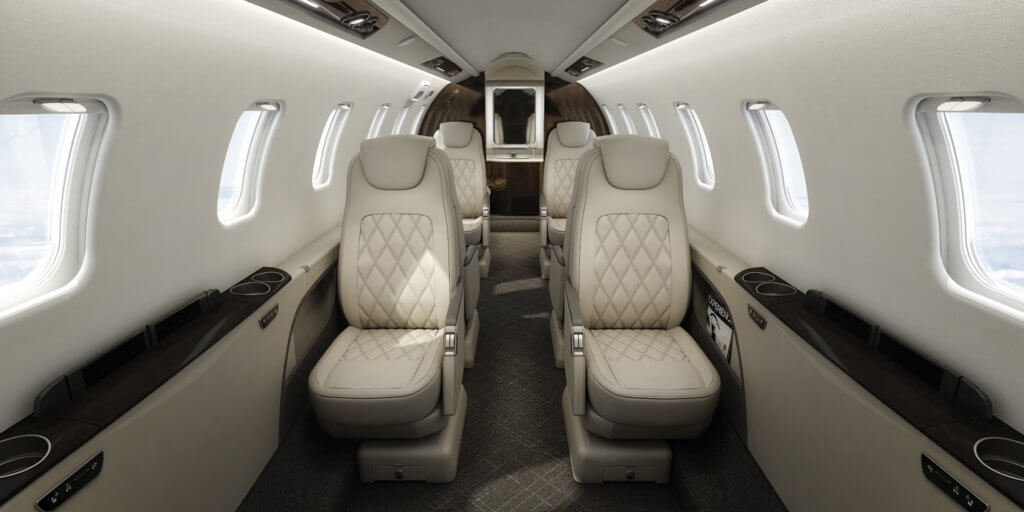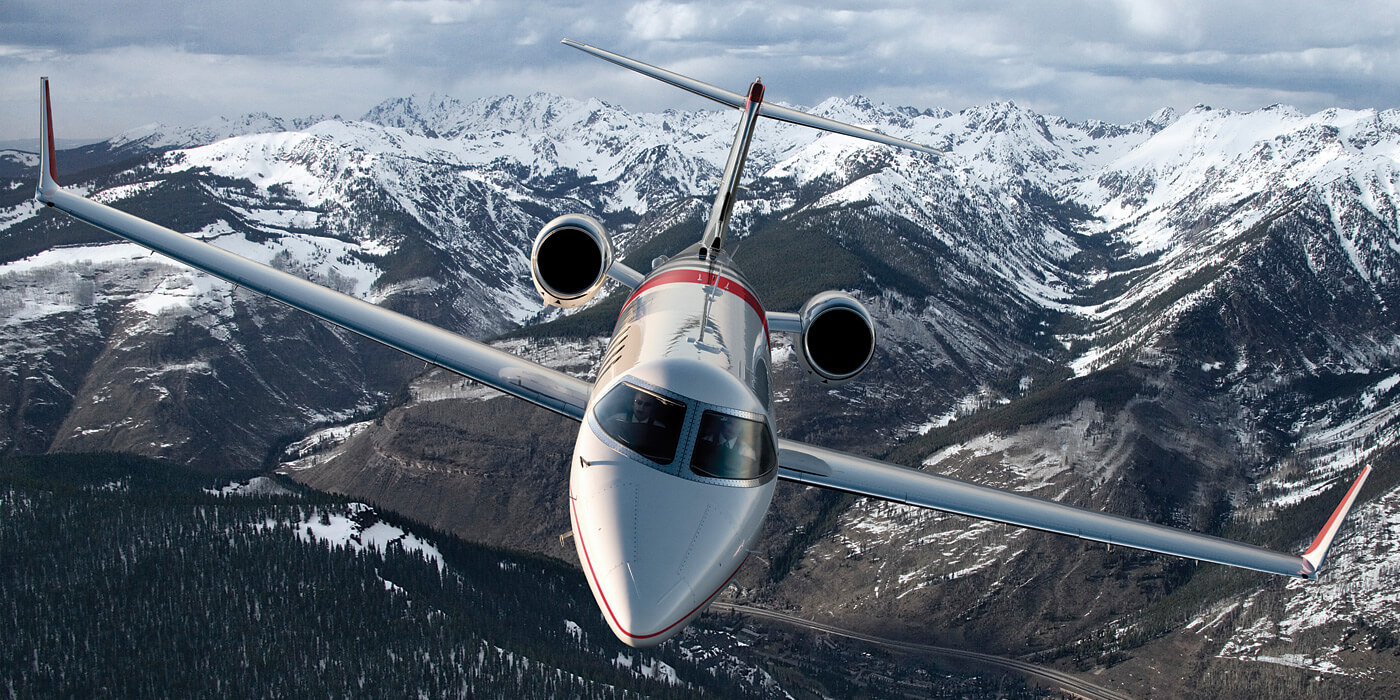Estimated reading time 10 minutes, 37 seconds.
It’s no accident that the Learjet 75 is a sexy airplane. No other word seems to suffice.

The very concept of executive travel was defined when the first Learjet took to the skies on Oct. 7, 1963. Since then “Learjet” has become a cultural synonym for stylish “jet set” mobility. Bill Lear, the renowned designer of the original Learjet, summarized his design ethos as, “If it looks good, it will fly good.”
There could be no doubt about the first half of that statement, but I was in Wichita to assess whether the latest Learjet, the Model 75, flew as good as it looked.
That first Lear 23 sold for US$489,000 when jet fuel was $0.27 per gallon. Learjet is still here, but times have certainly changed. When Skies flew the Lear 75 in June, rumours about the possible sale of Bombardier’s Learjet division had yet to surface. But by late summer, the industry was abuzz with speculation that the OEM was shopping for a buyer for the Learjet line.
Although its future may be uncertain, there is no question that the Learjet 75 we flew is the culmination of the same innovative brand that effectively spawned business aviation.
Reprising the Light Jet
Today’s Learjet 75 is a derivative of the successful “clean sheet” Lear 45, the first model designed after Bombardier acquired the brand in 1990. Their similarities are highlighted by the fact that the Model 45, the slightly down-sized Model 40 and the Model 75 all share a common type rating.
The Learjet 75 also shares the Model 45’s fuselage and systems, but “derivative” might not be the right word for an airplane that has been fundamentally re-thought. It features upgraded engines, new avionics and canted winglets that add three feet to the wingspan for improved aerodynamic efficiency. It was awarded its type certificate in November 2013 and 76 Learjet 75s had been delivered as of the second quarter of 2016.
The Learjet 75 is a Part 25 airplane, certified to Amendment 77 as was the Learjet 45, and retaining its admirable systems simplicity.
It has an unboosted flight control system with split-control reversion. There is a DC electric rudder boost to simplify handling in the event of an engine failure. The electrical system is a 28-volt DC split-bus design with two main batteries, plus an emergency battery in the nose. Fuel is stored in a wet wing and an aft fuselage tank, featuring single-point pressure refuelling. A single dual-pump hydraulic system with a DC electric back-up powers the undercarriage, multifunction spoilers, flaps, thrust reversers and brakes.
The Lear 75’s Honeywell RE-100 auxiliary power unit is certified for unattended operation, but is only available on the ground where it is essential to provide bleed air for cabin cooling or heating. The heated, unpressurized aft luggage compartment has 50 cubic feet of volume for up to 500 pounds of baggage.
The two Honeywell TFE731-40BR engines’ power was increased by 10 per cent to 3,850 pounds thrust (flat rated to +23C), which Bombardier claims reduces takeoff field distances by 12 per cent. They utilize digital electronic engine controllers (DEECs), with discrete throttle detents to simplify power management.
The Learjet 75 features the Garmin G5000-based “Vision” flight deck with three 14-inch landscape-oriented displays. It has touch screen controllers (TSCs) instead of keypads, radio tuning units and audio panels, providing a very tidy and utilitarian cockpit; however, unlike many other G5000 installations, the Learjet 75 features only one TSC per pilot.

Notwithstanding its other merits, the G5000 suite reduces weight by approximately 200 pounds over the Honeywell Primus 1000 system in the Learjet 45.
I flew the factory demonstrator, registration N751LJ, with Learjet demonstration pilot Brian Judd.
Welcome Aboard
Cockpit ingress reminded me that I was in a Learjet, meaning that the fuselage tapers toward the front! The overhead handle helped me mask my awkwardness. Once installed, I found the cockpit seats comfortable and the field of view quite satisfactory through the distinctive wrap-around Learjet windscreens.
The displays allow 60/40 split windows, which retain a generous primary flight display with enough room for an approach plate alongside. Engine data is displayed in a column on the left of the multi-function display (MFD). The caution and advisory system is fully integrated, and includes system synoptic displays.
I thought the TSCs required a slight reach, but found them overall to be very usable. The TSCs are Garmin’s “everything controller,” with full systems integration, which results in a very tidy cockpit. The overhead was clean, save for a small panel for lighting switches.
Taxi and Start-up
Judd used paper checklists for engine starting, although electronic checklists are also available. Most of the pre-flight checks were accomplished using a built-in test function.
After engine start, and with a bit of coaching, I entered our flight plan to Garden City Regional Airport (GCK), an aptly named vista in lovely, scenic Kansas. Judd demonstrated the takeoff performance calculations, using the optional performance database. Using downloaded weather for Wichita, the system calculated our V-speeds, takeoff and landing field lengths, pitch attitude target, and second segment climb data. So much for paper performance charts!
We taxied for Wichita’s Runway 19L with two humans onboard and 5,500 pounds of fuel for a gross takeoff weight of 19,215 pounds; 2,285 pounds below maximum takeoff weight of 21,500 pounds, leaving enough margin to fill the tanks to their 6,062 pound capacity and fill the eight seats. Impressive.
Judd was careful to brief me on the characteristics of the electro-hydraulic nosewheel steering system, offering warnings about its lack of centering. He needn’t have worried. I found it precise, predictable and pleasant, once one adapts to displacement versus pressure for steering control. It features speed-adaptive gains with 60 degrees of authority below five knots, tapering to seven degrees of steering authority above 70 knots.
Heading Upstairs
The Lear 75’s published takeoff distance is 4,440 feet at maximum weight under standard sea level conditions. We used the normal takeoff configuration of eight degrees flap with the multifunction spoilers armed for automatic deployment in the event of an abort. Acceleration was satisfying, and an estimated five-pound rotation force was sufficient to head us upwards. My first impressions were of responsive, if not exactly light, controls. The trim rate was ideal as we accelerated and cleaned up the jet.

Our admittedly light jet was maintaining an indicated climb rate of 4,150 feet per minute passing 10,000 feet, following the climb schedule of 250 knots indicated airspeed (KIAS) to 0.70 Mach. The autopilot did a good job damping summer turbulence. The climb rate remained strong, indicating 1,500 feet per minute passing 40,000 feet (FL400), and we levelled off at FL430 21 minutes after takeoff having burned 910 pounds of fuel.
Although the Learjet 75 is certified for FL510, Judd ventured that it’s a usable altitude only “when you’re pretty light.” FL450 is the maximum practical initial cruising altitude at maximum takeoff weight, under close to standard conditions.
I asked Judd about his typical en route power and he set an intermediate cruise setting. When things stabilized we were zipping along at 437 knots true airspeed (KTAS) or 0.78 Mach, with a total fuel flow of 1,040 pounds per hour under ISA -6C conditions. Bombardier boasts high speed cruise performance of 464 KTAS (0.81 Mach). Configured for maximum range it can fly 2,040 nautical miles with four passengers with a standard fuel reserve. My notes on ride quality read, “Quiet!”
The 9.3 pound per square inch cabin pressure differential provides a 6,450 foot cabin altitude at FL450. Judd performed a demonstration at FL430 by turning off the left engine bleed valve and selecting the wing, stabilizer and nacelle heats. The cabin altitude held steady. Clearly there is no shortage of bleed air.
The Business End of the Jet
The interior features a double club seating arrangement for eight, plus the belted and externally serviced lavatory. The fuselage has an oval cross-section, with a 4’11” tall cabin and a flat floor. It features cockpit pocket doors; an innovation in light jets which Bombardier claims reduces interior noise levels by eight decibels. The galley was generous for a light jet.
Lufthansa Technik provided the cabin management system (CMS), which is common to the Bombardier Challenger 350, and includes a seven-inch pop-up touch screen at six passenger seats. A 12.1-inch, high definition display is mounted on the forward cabin bulkhead. The system drives an immersive audio system. Broadband Internet is optional.
With two windows, the rear compartment felt bright and spacious, and can accommodate up to 15 cubic feet of in-flight accessible cargo.
Return to Earth
I hand flew the jet briefly at FL430 and found it pleasant and predictable. Steep turns were easily handled, if one is so inclined. Spoiler extension created only trace buffet in our descent back to Wichita. Suddenly, there was a surge in inbound traffic and we found ourselves subject to multiple delaying vectors. I was secretly thrilled.
I took advantage of the pause to perform a few stalls. The distinctive delta fins on the aft fuselage obviate the need for a stick pusher. With the yaw damper selected off, and in the clean configuration, I performed a slow idle deceleration and waited for something to happen. The shaker woke me at 126 KIAS, and there was a rapid onset of deterrent buffet passing 111 KIAS associated with a mild pitch break. In summary, it was a non-event, and rapid throttle response hastened the recovery.

With further unexpected free time, Judd suggested that we simulate a roll control jam, and demonstrate separation of the ailerons and spoilers; a Part 25 certification requirement. I flicked a toggle on the left yoke, leaving me with control of the multifunction spoilers and Judd controlling the ailerons. Control response is affected, but not significantly, and it’s nice to know that even this rare contingency was anticipated.
Suddenly, ATC remembered us and we were vectored for a steep intercept to a rushed final approach. Fortunately, the first notch of flaps may be deployed at 250 KIAS, making it easy to drop into the terminal airspace and slow down promptly. No flaps are allowed with the multi-function spoiler deployed, owing to buffet. Our approach speed (Vref) was 118 KIAS and the calculated landing distance was 2,664 feet at a weight of 17,656 pounds, again using uploaded weather data and the onboard performance database.
I found the flare pleasantly light and predictable, and the trailing link undercarriage provided a soft touchdown. The combination of carbon brakes, thrust reversers and automatic spoiler deployment conspired to smoothly hasten deceleration.
The Learjet Experience
As a Part 25-certified light jet, the Learjet 75 occupies something of a niche. Bombardier sees its competition as including the Embraer Phenom 300 and the Cessna Citation CJ4, but those are Part 23 aircraft designed to simpler criteria. Only the Citation XLS+ is a comparable Part 25 light jet.
Suffice to say that the light jet market is well served. Sales of the Learjet 75 haven’t exactly been on fire to date, but perhaps that says more about the current state of the light jet market than the Learjet 75.
The Learjet 75 represents the pinnacle of a brand that has been undergoing continual refinement for more than half a century. It is almost certainly the best Learjet yet.


Helpful information. Lucky me I discovered your web site by accident,
and I am stunned why this accident did not happened in advance!
I bookmarked it.